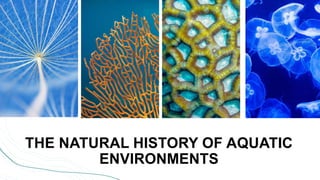
Marine Ecosystem.pptx
- 1. THE NATURAL HISTORY OF AQUATIC ENVIRONMENTS
- 2. AQUATIC ECOSYSTEM An aquatic ecosystem is an ecosystem in a body of water. Communities of organisms that are dependent on each other and on their environment live in aquatic ecosystems. TYPES *The two main types of aquatic ecosystem are marine ecosystems and freshwater ecosystems. MARINE ECOSYSTEM Are aquatic ecosystems whose waters possess a high salt content. Out of all of the types of ecosystems on the planet, marine ecosystems are the most prevalent. They teem with life, providing nearly half of the Earth`s oxygen and a home for a wide array of species. Examples for marine ecosystem includes salt marshes, intertidal zones, estuaries, lagoons, mangroves, coral reefs, the deep sea, and the sea floor. Presentation title 2
- 3. FRESHWATER ECOSYSTEM Cover 0.80% of the Earth`s surface and inhabit 0.009% of its total water. Freshwater contain 41% of the world`s known fish species. Theses have low level of salt content when compared to marine ecosystem. There are three basic types of freshwater ecosystems: LENTIC – they are slow moving waterbodies like ponds, and lakes. Lentic refers to stationary or relatively still freshwater, from the Latin lentus, which means “sluggish”. *LITTORAL ZONE – is the shallow zone near the shore. This is where rooted wetland plants occur. The offshore is divided into two zones: OPEN WATER ZONE, sunlight supports algae and the species that feed upon them. DEEP WATER ZONE, sunlight is not available and the food web is based on detritus entering from the littoral and photic zones. *BENTHIC ZONE – bottom area of lake or pond consisting of decomposers, larvae of insects, and clams. LOTIC – they are faster moving waterbodies like stream and rivers. From the Latin lotus, meaning washed. WETLANDS – they are the areas where the soil is saturated or inundated for some of the time. There are four main types of wetlands: swamp, marsh, fen, and bog.
- 4. FUNCTION Aquatic ecosystems perform important environmental functions. They recycle nutrients, purify water, attenuate floods, recharge ground water and provide habitats for wildlife. Aquatic ecosystems are also used for human recreation and very important to the tourism industry, especially in coastal regions.
- 5. CHARACTERISTICS: ABIOTIC CHARATERISTICS – some of the important abiotic environmental factors of aquatic ecosystems include: Substrate type Water depth Nutrient levels Temperature Salinity Flow Dissolved oxygen Nutrient levels
- 6. BIOTIC CHARATERISTICS – are mainly determined by the organisms that occur. Wetland plants may produce dense canopies that cover large areas of sediment. And snails or geese may graze the vegetation leaving large mud flats. These biotic factors can be classified into three groups: Producer, aquatic plants like algae, volvox, Closterium, hydrilla, and so on. Small animal which depends on plants for their food are primary consumers, also the one who eats the primary consumers can be called, either secondary or tertiary consumer. Decomposers, like bacteria, fungi, and other microorganisms decomposes the dead bodies and mix it to the soil which acts as the nutrients of producer.
- 7. POPULATION GENETICS • Population genetics is the study of change in the frequencies of allele and genotype within a population. • Population geneticists study the genetic structure of populations, and how they change geographically and over time. • Gene – a discrete unit of hereditary information consisting of a specific nucleotide sequence in DNA. • Alleles – alternative forms of a gene. • Genotype – the genetic makeup of an individual. • Phenotype – the physical traits of an organism. 20XX 7
- 8. WHY ALLELE FREQUENCIES CHANGE • Five evolutionary forces can significantly alter the allele frequencies of a population MIGRATION • Movement of individuals from one population to another - Immigration: movement into a population - Emigration: movement out of a population • A very potent agent of change MUTATION • Errors in DNA replication • The ultimate source of new variation.
- 9. WHY ALLELE FREQUENCIES CHANGE • Five evolutionary forces can significantly alter the allele frequencies of a population NONRANDOM MATING • Mating that occurs more or less frequently than expected by chance - Inbreeding: mating with relatives and increases homozygosity - Out breeding: mating with non-relatives and increases heterozygosity. GENETIC DRIFT • Random loss of alleles - Founder Effect: small group of individuals establishes a population in a new location. - Bottleneck Effect: a sudden decrease in population size to natural forces.
- 10. WHY ALLELE FREQUENCIES CHANGE • Five evolutionary forces can significantly alter the allele frequencies of a population SELECTION • Some individuals leave behind more offspring than others. - Artificial selection: breeder selects for desired characteristics - Natural selection: environment selects for adapted characteristics
- 11. TYPES OF VARIATION Phenotypic variation – it`s a genetical basis morphological variation its some tie continuous and sometimes discontinuous. Example: salmonberry and two-spotted ladybird beetle
- 12. TYPES OF VARIATION Genetic variation – the variance that is due to variation among individuals in the alleles that they have, excludes environmentally-caused variation. Natural selection – is a process by which heritable traits that makes it more likely for an organisms to survive and successfully reproduced become more common in population over successive generation.
- 13. FORMS OF SELECTION Three types of natural selection have been identified: • Stabilizing selection: acts to eliminate both extreme phenotypes • Disruptive selection: acts to eliminate intermediate phenotypes • Directional selection: acts to eliminate a single extreme phenotype
- 14. THANK YOU! 20XX Presentation title 14